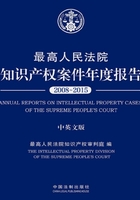
ANNUAL REPORT ON INTELLECTUAL PROPERTY CASES OF THE SUPREME PEOPLE'S COURT (2009)
Preface
With the further improvement of the judicial protection mechanism for intellectual property rights(IP)and the implementation of the Civil Procedure Law of the People's Republic of China(Amendment),in 2009,the Intellectual Property Division of the Supreme People's Court(IP Division)saw a continuous increase in the accepted IP cases and a considerable growth in concluded ones,enabling the Supreme People's Court(SPC)to effectively play its role of judicial supervision and professional guidance in the trial of IP cases.
In 2009,the IP Division received a total of 297 IP cases of various types and recorded a total of 440 cases at bar,as well as 143 unresolved cases from 2008,amounting to a year-on-year increase of 33.7%.New cases accepted in 2009 of different types of right included 121 patent cases,61 trademark cases,41 copyright cases,10 trade secret cases,9 cases involving other kinds of unfair competition,7 cases concerning IP contracts,1 case involving a new variety of plant,and 47 cases requesting for instructions(most of them involving the ascertainment of jurisdiction over IP cases).According to the trial procedures,8 were second instance cases,230 were cases to be retried,12 were cases to be reviewed,and 47 requesting for instructions.A total of 390 IP cases of various types were concluded in 2009,representing a jump of 111.96%over 2008.Of the concluded cases,10 were second instance cases,319 were cases applying for retrial,14 were cases lodged for review,and 47 requested instruction.Of the concluded cases applying for retrial,the applications of 212 cases were rejected,12 were ruled for trial,43 were instructed to be retried,28 were withdrawn upon settlement,21(cases for retrial of some IP administrative applications)were transferred to the court of first instance for review and handling,and 3 were handled in other ways.
The IP cases tried by the SPC in 2009 presented the following characteristics:an increase in new types of cases and materially complex and difficult cases,the increase of social influence,stronger professionalism and technical properties and increased difficulty in trial,and a rising proportion of foreign-related cases,thus attracting more and more international attention.New types of complex and difficult cases continuously broke legal boundaries,which accordingly produced new areas to be regulated by the law and created new stronger judicial demands.Through the hearing and verdicts of individual cases,the SPC conducted in-depth studies of new issues and areas and made timely responses to them,thus clarifying ambiguous legal boundaries,identifying the directions at the crossroads and creating rules for unprecedented cases.The ruling of these cases reflected the creative efforts of the SPC in maintaining harmony between stability and changes in the law,maintaining the balance between private interest and public interest and achieving the unification of legal effect and social effect.In the ruling of these cases,as the highest judicial organ of the PRC,the SPC not only finally resolved the disputes between the parties concerned,but also established codes of conduct for the public,ascertained the legality of corporate competition modes,and guided the development direction of the businesses concerned and the whole industry,thus continuously pushing ahead the progress of China under the IP law with its unique constitutional status and judicial behavior.
In order to sum up the experience of publishing the initial Annual Report On Intellectual Property Cases of the Supreme People's Court(2008)in 2009,the SPC selected 37 typical cases with general guiding significance from among cases with final conclusive verdicts in the year,prepared the annual report in a new writing style and had it published.It should be noted that although some cases are typical,particularly most IP cases to be retried by a people's court of higher level as instructed by the SPC,according to the relevant provisions of the procedural law,the SPC did not make final conclusive remarks on such cases.For this reason,these cases were not included in the Annual Report.